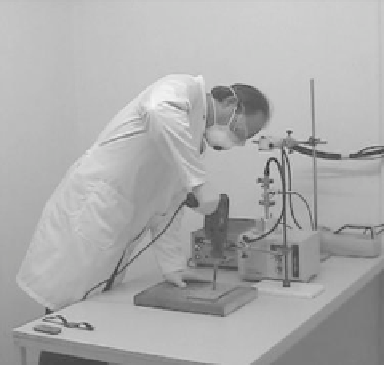Biomedical Engineering Reference
In-Depth Information
FIGURE 13.4
Investigations of nano-object release from nanomaterials during drilling.
top-down approach (attrition/milling) has low energy efficiency and produces inho-
mogeneous particle sizes. Aerosol spray methods atomize a solution or suspension
and heat the droplets (in furnace or flame) to produce solid particles, which are then
collected by precipitation. In addition, inert gas condensation processes exist with or
without catalytic interaction, that is, chemical vapor deposition (CVD) and physical
vapor deposition, respectively. All these processes have different potentials of releas-
ing NOAA into the workplace environment, here especially as aerosols.
A few workplace or simulated workplace studies that fell into this source domain
have been published after the Kuhlbusch et al. (2011) review or were not included
(Table 13.1). In general, the most frequently studied process of synthesis is flame
spraying (Leppänen et al. 2012; Walser et al. 2012; Koivisto et al. 2011; Koponen
et al. 2013), which is a relatively open process where synthesis and collection take
place in a fume hood. The spray process is a well-controlled process that may gen-
erate small sized primary particles, for example, 10-20 nm with a narrow distri-
bution, for example, geometric standard deviation (GSD) < 1.8. However, due to
high concentration, that is, above 10
6
cm
−3
, coagulation may cause a shift of size
mode. During normal production conditions some synthesized nanoparticles could
be emitted, usually resulting in low breathing zone concentrations. Anyhow, it has
been demonstrated that these particles will dominate the deposition in the alveolar
region. Other processes like nano-objects production by CVD (Ogura et al. 2011;
Lee et al. 2011) show a release of NOAAs (here CNT) only during the opening of the
reactor. In addition, a relatively high elevation of the concentration compared to the
background was reported during the preparation of the catalyst for CNT production
using the CVD process. In more industrial scale operations the reactor room can be
separated from other workplace, thus preventing these emissions from the reactor
into workplace areas (Wang et al. 2012).
Not all studies assessed size distribution over a wide range of particle sizes,
that is, from 10 nm to 10,000 nm, but usually limited this to the submicron range.

Search WWH ::

Custom Search